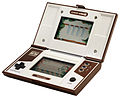History of video games/Platforms/Game & Watch series
History[edit | edit source]

Development[edit | edit source]
Gunpei Yokoi came up with the idea for the Game & Watch while watching a businessman fiddle with a calculator while traveling on the Shinkansen (Bullet Train).[1] A chance incident requiring Gunpei Yokoi to drive Nintendo president Hiroshi Yamauchi to a meeting allowed him to pitch the idea, with approval being suddenly granted after a week of consideration.[2]
Sharp produced the electrical components used in the Game & Watch.[3] Engineers were split between hardware and software roles for development of the Game & Watch units.[3] Development pace for the Game & Watch series was frantic, and developers were usually focused on quickly developing new units.[4] While at least some of the developers of the Game & Watch were not informed of hard sales numbers, they were pressed into the sales at busy times to sell their own console in stores, which helped them better understand what their customers wanted.[4]
Legacy[edit | edit source]

The D-Pad pioneered on the Game & Watch units was reused in subsequent Nintendo consoles, such as the Famicom/Nintendo Entertainment System.[3] The Game & Watch series sold 43.4 million units worldwide, with 30.53 million consoles sold outside of Japan, 12.87 million consoles sold inside Japan, and with 9 models of the console being attributable to selling over a million sales each.[4][5]
The Game & Watch line would see several continuations into the 2020's, either as in game homages, special edition themed consoles, software complications or even hardware releases such as the Nintendo Mini Classics series, and the Game & Watch: Super Mario Bros. console.
Technology[edit | edit source]
Game & Watch consoles reused calculator chips, and simply used displays with graphics rather than numbers to achieve the desired effect.[1]
The 4-bit Sharp SM5X series of microcontrollers served as the processor for Game & Watch units.[6]
The clock functionality was implemented with the use of a crystal oscillator.[1]
Due to their uncomplicated electronics and rugged design Game & Watch units tend to be reliable.[7]
Game library[edit | edit source]
Development[edit | edit source]
Clone consoles[edit | edit source]
References[edit | edit source]
- ↑ a b c "Iwata Asks". iwataasks.nintendo.com. Retrieved 25 October 2020.
- ↑ "How Gunpei Yokoi Reinvented Nintendo". www.vice.com. Retrieved 28 November 2020.
- ↑ a b c O'Kane, Sean (18 October 2015). "7 things I learned from the designer of the NES". The Verge. Retrieved 30 October 2020.
- ↑ a b c "Iwata Asks". iwataasks.nintendo.com. https://iwataasks.nintendo.com/interviews/#/clubn/game-and-watch-ball-reward/0/3.
- ↑ "The Million Selling Nintendo Game & Watch (G&W) Games - Warped Factor - Words in the Key of Geek.". www.warpedfactor.com. http://www.warpedfactor.com/2020/11/the-million-selling-nintendo-game-watch.html.
- ↑ "mamedev/mame". GitHub. Retrieved 1 November 2020.
- ↑ Life, Nintendo (8 September 2020). "Feature: How Nintendo's Game & Watch Took "Withered Technology" And Turned It Into A Million-Seller". Nintendo Life. Retrieved 1 November 2020.

























